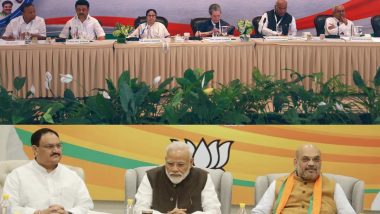New Delhi, July 26: Opposition parties, including those, belonging to the Indian National Developmental Inclusive Alliance (INDIA) bloc, have decided to move a no-confidence motion against the BJP government in the Lok Sabha, citing concerns over the ongoing strife in Manipur, during the monsoon session today, July 26. Congress MP Gaurav Gogoi and BRS lawmaker Nama Nageswara Rao filed separate no-confidence motion against the Modi government in Lok Sabha today.
A no-confidence motion, if adopted and a majority of MPs votes in favour of it, leads to fall of the ruling government. What is a no-confidence motion? Can Modi government survive a no-trust vote? Here's all you need to know about the no-confidence motion.
What Is a No-Confidence Motion?
A No-Confidence Motion is a formal parliamentary motion moved by the opposition parties in the Lok Sabha to express a lack of confidence in the ruling government. To succeed, the motion requires a simple majority in the house, meaning more votes in favour than against. If the government loses the no-trust vote, the Prime Minister and the entire cabinet must resign. Monsoon Session 2023: Centre to Table Constitution Order Bill in Rajya Sabha for Inclusion of Certain Communities of Himachal Pradesh in ST List.
Who Can Move a No-Confidence Motion, and How is it Moved?
Any member of the Lok Sabha can move a no-confidence motion, but to do so, they need the support of at least 50 members of the House. The motion must be in writing and signed by the member proposing it. Once prepared, the motion is submitted to the Speaker of the Lok Sabha on a day when the House is in session. Parliament Monsoon Session 2023, Day 5: No-Confidence Motion by INDIA Parties Against Modi Government Likely to Persist 'Logjam'.
The Process of Debate and Voting on the Motion
After the motion is submitted, the Speaker of the Lok Sabha decides whether to admit it for discussion and debate. If admitted, the Speaker sets the date and time for the discussion. During the debate, the member who submitted the no-confidence motion initiates the proceedings, followed by a response from the government. The Lok Sabha votes on the no-confidence motion after the debate. For the motion to pass, it needs the support of a majority of the members present and voting in the House. If the majority supports the motion, the government is compelled to resign.
Will Modi Government Survive No-Trust Vote?
If the no-confidence motion is adopted, followed by voting, the Modi government will most likely defeat it. The BJP is the largest party in the Lok Sabha, with 301 seats out of 543. The Congress is the second largest party, with 49 seats. The DMK has 24 seats, and the TMC has 23 seats. The NDA, a coalition of parties led by the BJP, has a total of 332 seats in the Lok Sabha. The erstwhile UPA, which has now become a new coalition called INDIA with more members, has a total of 91 seats in the Lok Sabha.
Independents and members of smaller parties hold the remaining seats. Considering the BJP's strength in the Lower House, it is safe to say the Modi government would survive the no-trust vote.
(The above story first appeared on LatestLY on Jul 26, 2023 10:54 AM IST. For more news and updates on politics, world, sports, entertainment and lifestyle, log on to our website latestly.com).













 Quickly
Quickly





















